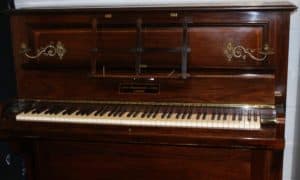 Despite major search, no owner identified for 900 coins from 1847 to 1915 stashed in piano donated to Shropshire college
Despite major search, no owner identified for 900 coins from 1847 to 1915 stashed in piano donated to Shropshire college
A hoard of more than 900 gold sovereigns found hidden in a donated school piano has officially been declared as treasure as the coins’ original owner and the reasons for them being so covertly stashed still remains a mystery.
Piano technician Martin Backhouse, 61, was astonished to discover the coins, found hidden under the upright’s keyboard and carefully stitched into seven cloth packets and a leather drawstring purse.
He had been called in to tune the 110-year-old instrument at Bishop’s Castle community college in Shropshire, which received the piano last year from a couple who were “downsizing” their home.
The hoard, the largest of its kind consisting of 633 full sovereigns and 280 half sovereigns dating between 1847 and 1915, was declared to be treasure by Shrewsbury coroner John Ellery. He said it was substantially made of gold or silver, was deliberately concealed by the owner with a view to later recovery, but that the owner, or his or her present heirs or successors, remained unknown.
No viable claimants have been found, despite a three-month appeal. Ownership now lies with the crown, and an treasure valuation committee at the British Museum will place a value on the hoard. Backhouse and the college stand to share any reward.
Backhouse, a keen amateur archaeologist more used to discovering Neolithic finds, told the Guardian it was likely no work had been carried out on the piano since it was manufactured in 1906.
“I found the keys were a bit sluggish, so, as a technician, what I do is take all the keys out. When I started taking the keys out at the top treble, I thought ‘what’s that packaging underneath? That’s old. That’s white corduroy.’ Then I noticed it was very nicely stitched. I thought ‘well, that can’t be moth balls’.
“I lifted one out. It was very nicely wrapped, very stiff, all neatly designed specifically to fit in the piano. Very carefully done and very heavy. I cut off the end with my penknife and it was gold coins.”
Stunned, he put the piano parts back together, so nobody would see it and went straight to the school office to find the headteacher. He then pulled out the rest of the keys “and we really discovered the size of the hoard then”.
The coins, the majority from Victoria’s reign, were a mixture of 91.7% pure gold and silver. In total, there was equivalent of more than 6kg of gold bullion.
Together with Peter Reavill, the British Museum’s finds liaison officer for the region, Backhouse has tried to piece together the piano’s history, a task he described as a fascinating journey “with so many red herrings”.
One of the sovereign-filled packages was packed in cardboard from an advertising board for the breakfast cereal Shredded Wheat, which dated the hiding of that package to between 1926-46.
The piano was made in 1906 by Broadwood & Sons of London and sold to a music shop, Messrs Beaven & Mothersole, in Saffron Walden, Essex.
After some missing years, whereabouts unknown, it was bought in 1983 by Graham and Meg Hemmings, then living in the Saffron Walden area, so their four children could learn to play.
The couple put it in storage for a short time when they moved to Bishop’s Castle, Shropshire, in 2005. In 2016, downsizing because their children had left home, the couple “gladly donated” it to the community college which had appealed for instruments for pupils.
Meg Hemmings, 65, said they had no idea that the iron-framed upright, which came complete with two candlestick holders, housed such an amazing mystery, although it had been tuned “from time to time”.
She added: “The sadness is, it’s not a complete story. They’ve looked and searched for the people and they unfortunately haven’t come forward. It’s an incomplete story – but it’s still an exciting story,.”
The coroner heard that the coins would have been worth £773 in 1926, well above the £619 cost of an average four-bedroomed house at the time. The hoard was probably “repackaged” some time during the Great Depression.
Gold sovereigns vary in value, but good quality examples of first world war-era ones can fetch £375 each.
Legally, if museums now acquire the coins, Backhouse, as finder, and the school, as owner, would split any reward, which is usually the value of the find.
Backhouse said he had no clue how much he would receive, adding “it doesn’t worry me”. A percentage would go to his church and, as he now has tinnitus, which makes his job difficult, he was hoping for semi-retirement.
More than 40 people came forward with information or to make claims which had been rigorously investigated but did not satisfy investigators. The coroner said: “We simply do not know how they [the coins] came to be concealed.”
Reavill said the hoard was “one of the best items of treasure I have worked on” and had been hidden with “great care and attention to detail”.
“The biggest surprise in the hoard is definitely the Shredded Wheat packaging dating to 1926, 11 years after the collection of the coins,” he said, adding that it “suggests that the hoard had been packaged and hidden in several places over time”.
He continued that the mystery of the coins “rivals the best detective fiction out there”. When he first saw the find laid out, he said, “I was like ‘whoa’.”
Kathy Dowbiggin, business manager at the college, said: “The find was something that none of us could possibly have imagined. After the initial shock, surprise and excitement, we had to quickly decide what to do next. We photographed the packages in situ, numbered and photographed each package and placed them in the school safe.
“After carrying out some internet-based research into gold sovereigns and the Treasures Act 1986 we agreed that the coins were a significant find and should be reported to the coroner.”
If a genuine claimant comes forward, it will be a matter for the civil court.
SOURCE: https://www.theguardian.com/uk-news/2017/apr/20/gold-sovereign-hoard-found-college-piano-declared-treasure?CMP=share_btn_fb

